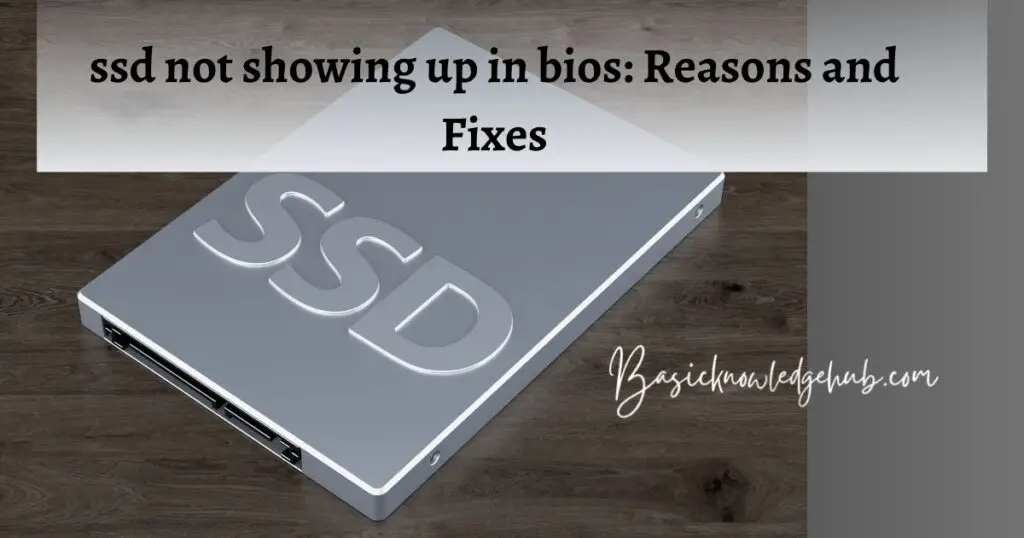SSD not showing up in bios: Reasons and Fixes
Every computer user knows the pain of facing unusual issues. A popular one is your SSD not showing up in BIOS. This issue can leave you scratching your head, not knowing what’s wrong. Don’t worry, we’ve got you covered. This article will provide you with a comprehensive guide on why this might be happening and how to fix it.
Reasons behind your SSD not showing up in BIOS
Understanding the common reasons behind your SSD not showing up in BIOS is crucial in troubleshooting and rectifying this issue. Let’s take a look at these potential culprits.

Reason 1: SSD Not Properly Connected
One of the most fundamental reasons can be an improper connection. If the SSD is not adequately connected to the motherboard, BIOS may not recognize it.
Reason 2: BIOS Not Updated
An outdated BIOS might not be compatible with your SSD, which can prevent it from showing up in BIOS. Regular updates are essential to ensure smooth functioning of your system.
Reason 3: SSD Is Not Initialized
If your SSD is not initialized, the BIOS won’t recognize it. Initialization prepares the SSD for use, creating necessary partitions and file systems.
Reason 4: SSD Is In Incorrect Port
The SSD might not be detected if it’s connected to an incorrect port. Certain SATA ports may not be active or compatible, causing the SSD to remain undetected.
Reason 5: SSD Has a File System BIOS Can’t Recognize
Your SSD may have a file system that your BIOS can’t recognize, which can lead to the SSD not showing up in BIOS. Compatibility between the file system and BIOS is crucial for detection.
Reason 6: BIOS Settings
Incorrect BIOS settings can also prevent your SSD from being detected. If the settings related to hard drives and SSDs are not configured properly, it could lead to this issue.
Remember, identifying the root cause is the first step towards resolving any technical issue. With these common reasons in mind, you’ll be better equipped to diagnose and fix the problem of an SSD not showing up in BIOS.
Also read: Troubleshooting Roblox FPS Unlocker Not Working: Reasons and Fixes
How to fix SSD not showing up in bios?
Fix 1: Checking and Reconnecting the SSD
- Step 1: Power Down Your System – Ensure your computer is completely turned off before you start. Safety first!
- Step 2: Open Your Computer Casing – You might need a screwdriver for this. Remember, a static discharge can damage the components. Ground yourself by touching an unpainted metal before you touch any components.
- Step 3: Locate Your SSD – The SSD is typically located in the hard drive bay of your computer. It’s rectangular and smaller than a traditional HDD.
- Step 4: Check the Connections – The SSD will be connected via two cables: a power cable (from the power supply) and a data cable (to the motherboard). Make sure both are properly connected.
- Step 5: Reconnect If Needed – If you notice any loose connections, reconnect the cables. Ensure the connectors click into place.
- Step 6: Close Your Computer Casing – Once you’ve checked and rectified the connections, put the casing back on.
- Step 7: Power On Your System – Turn on your computer and access the BIOS. If your SSD was not properly connected, it should now appear in BIOS.
This solution is relatively simple and often overlooked. Yet, it is a common reason why an SSD might not be showing up in BIOS. By ensuring the SSD is correctly and securely connected, you can eliminate this potential problem.
Fix 2: Updating the BIOS
- Step 1: Identify Your Current BIOS Version – Access your BIOS setup to find out the current version. Usually, this information is displayed on the BIOS home screen.
- Step 2: Check for Updates – Visit the manufacturer’s website. Find the support or downloads section. Input your model number and check if there’s an updated BIOS version available.
- Step 3: Download the Update – If there’s a newer version, download it. The file will typically be in a .exe or .bin format.
- Step 4: Read the Instructions – Every BIOS update is unique. Carefully read the instructions provided by the manufacturer before proceeding.
- Step 5: Backup Your Data – BIOS updates can sometimes fail, leading to data loss. It’s crucial to backup your important files before proceeding.
- Step 6: Run the Update – Run the downloaded file or follow the manufacturer’s instructions to update your BIOS.
- Step 7: Restart Your System – Once the update is complete, restart your system. Access your BIOS to see if the SSD is now detected.
Remember: Updating BIOS is a delicate procedure. A failed update can render your computer unbootable. Always follow the manufacturer’s instructions to the letter. If you’re uncomfortable performing the update, consider seeking professional help. Proper BIOS updates can rectify the issue of an SSD not showing up in BIOS by providing support for newer hardware technologies.
Fix 3: Initializing the SSD
- Step 1: Access Disk Management (Windows) / Disk Utility (macOS) – For Windows users, press Windows+X and select ‘Disk Management’. For macOS users, go to ‘Utilities’ and open ‘Disk Utility’.
- Step 2: Identify Your SSD – You should see a list of all storage devices connected to your computer. The SSD may show as ‘Unallocated’ or ‘Not Initialized’.
- Step 3: Right-click and Initialize (Windows) / Erase (macOS) – If you’re using Windows, right-click on your SSD and select ‘Initialize Disk’. On macOS, select the SSD and click on ‘Erase’.
- Step 4: Select the Correct Partition Style – You will have to choose between ‘MBR’ (Master Boot Record) or ‘GPT’ (GUID Partition Table). Generally, for newer systems and larger drives, ‘GPT’ is recommended.
- Step 5: Complete the Initialization – Follow the on-screen instructions to complete the initialization.
- Step 6: Check BIOS – Restart your system and access BIOS. Your SSD should now be detected.
Note: If you’re using Linux, you can use the fdisk command to initialize your SSD. Remember, initializing an SSD will erase all data on it. If there’s any data you need, make sure to back it up before you proceed. This process prepares your SSD for use, making it recognizable to the system and resolving the issue of the SSD not showing up in BIOS.
Fix 4: Changing the SSD Port
- Step 1: Power Down Your System – As always, safety comes first. Turn off your computer before making any hardware changes.
- Step 2: Open Your Computer Casing – Use a screwdriver if needed and remember to ground yourself to prevent any static damage.
- Step 3: Locate Your SSD – You will find the SSD in the hard drive bay of your computer, connected to the motherboard via a data cable.
- Step 4: Identify an Alternate Port – Look for an unused SATA port on your motherboard. You should find it close to the existing ports.
- Step 5: Change the SSD Port – Carefully disconnect the data cable from the current port. Connect it to the newly identified port. Ensure it clicks into place for a secure connection.
- Step 6: Close Your Computer Casing – After changing the port, close the computer casing properly.
- Step 7: Power On Your System – Turn on your computer. Access your BIOS to check if the SSD is now detected.
Sometimes, certain SATA ports might not be enabled or may have compatibility issues that prevent the SSD from showing up. Changing to a different SATA port can resolve this problem, making the SSD detectable in BIOS.
Fix 5: Changing the File System
- Step 1: Backup Your Data – Changing the file system will erase all data on the SSD. It is crucial to back up any important files before you start.
- Step 2: Access Disk Management (Windows) / Disk Utility (macOS) – For Windows users, press Windows+X and select ‘Disk Management’. For macOS users, go to ‘Utilities’ and open ‘Disk Utility’.
- Step 3: Identify Your SSD – Find your SSD in the list of all storage devices connected to your computer.
- Step 4: Right-Click and Format (Windows) / Erase (macOS) – On Windows, right-click on your SSD and select ‘Format’. On macOS, select the SSD and click ‘Erase’.
- Step 5: Select the Correct File System – Choose a file system that your BIOS can recognize. For most users, ‘NTFS’ (Windows) or ‘APFS’ (macOS) should work.
- Step 6: Complete the Formatting – Follow the on-screen instructions to format the SSD.
- Step 7: Check BIOS – Restart your system and access BIOS. If the issue was due to an incompatible file system, your SSD should now be detected.
Note: For Linux users, you can use the ‘mkfs’ command to change the file system. Changing the file system to a format that your BIOS recognizes can help resolve the issue of the SSD not showing up in BIOS.
Fix 6: Adjusting BIOS Settings
- Step 1: Restart Your Computer – You need to access the BIOS setup. Typically, this can be done by pressing the ‘Delete’, ‘F1’, ‘F2’, ‘F10’, or ‘Esc’ key while the system is booting up. The exact key depends on your motherboard model.
- Step 2: Access BIOS Setup – Once in the BIOS setup, you will see several tabs.
- Step 3: Locate the SATA or NVMe Settings – These settings are typically found under the ‘Advanced’, ‘Storage’, or ‘Boot’ tabs. If you’re unsure, refer to your motherboard’s manual.
- Step 4: Check the Settings – Ensure the settings related to SATA or NVMe are correct. Your SSD should be listed as a boot option if it’s detected by the BIOS.
- Step 5: Change the Settings If Needed – If the settings are incorrect, adjust them. You may need to enable ‘AHCI’ mode for SATA drives or ‘NVMe’ mode for NVMe drives. Again, refer to your motherboard’s manual for specific instructions.
- Step 6: Save and Exit – After adjusting the settings, save and exit the BIOS setup. Your system will restart.
- Step 7: Check BIOS Again – Access your BIOS setup again. Your SSD should now be detected.
This fix is related to your system’s BIOS settings. If they are not set up correctly, it could be the reason why your SSD is not showing up in BIOS. Adjusting the BIOS settings to correctly accommodate your SSD can often resolve this issue.
Fix 7: Updating SSD Firmware
- Step 1: Identify Your SSD’s Model and Firmware Version – You can usually find this information on the SSD itself or its packaging. If not, software tools like ‘CrystalDiskInfo’ for Windows can help identify it.
- Step 2: Check for Firmware Updates – Visit the SSD manufacturer’s website. Find the support or downloads section. Input your SSD model and check if there’s a newer firmware version available.
- Step 3: Download the Firmware Update – If there’s a newer version, download it. Make sure to read any provided instructions.
- Step 4: Backup Your Data – Updating firmware can sometimes result in data loss. Ensure to backup your important files before proceeding.
- Step 5: Apply the Firmware Update – The process for updating SSD firmware varies by manufacturer. Some provide a software utility, while others might require creating a bootable USB. Follow the instructions provided by the manufacturer.
- Step 6: Restart Your System – Once the firmware update is complete, restart your system. Access your BIOS to see if the SSD is now detected.
Remember: Updating firmware is a sensitive process. Any interruption can render your SSD unusable. Always follow the manufacturer’s instructions carefully. Keeping your SSD’s firmware updated can ensure compatibility with your system and BIOS, resolving the issue of an SSD not showing up in BIOS.
Fix 8: Using a Different Computer or SSD
If all else fails, there could be a hardware issue with either the SSD itself or your computer. To isolate the problem, you can try the following steps.
- Step 1: Try a Different SSD – If you have access to another SSD (make sure it’s in working condition), install it on your computer. If it shows up in BIOS, your original SSD could be faulty.
- Step 2: Test Your SSD on a Different Computer – Conversely, you can try connecting your SSD to a different computer. If it’s detected on the other machine, there could be an issue with your original computer.
These steps can help determine whether the issue is with the SSD itself, the motherboard, or another component in your computer. If your SSD is faulty, you may need to consider a replacement. If the computer is at fault, you should contact a professional or the manufacturer for further support. Testing the SSD on a different system or with a different SSD helps pinpoint the cause and allows you to find the most appropriate solution to the issue of an SSD not showing up in BIOS.
Preventing the SSD Not Showing Up in BIOS Issue
Now that we have discussed various fixes for when an SSD is not showing up in BIOS, let’s look at some preventive measures that can help you avoid this problem in the future.
- Regularly Update Your BIOS and SSD Firmware: Keep your BIOS and SSD firmware up-to-date. This ensures maximum compatibility between the system and the SSD.
- Correct BIOS Settings: Always make sure the BIOS settings are correctly configured. This includes ensuring the SATA or NVMe modes are correctly set according to your SSD.
- Properly Connect the SSD: When installing the SSD, ensure it is properly connected. Both the power and data cables should be securely fitted.
- Use Correct Ports: If your motherboard has multiple SATA ports, use the ones that are known to be working well. Some motherboards have specific ports for boot drives.
- Handle SSDs Carefully: SSDs are delicate. Handle them with care to prevent any physical damage.
- Regular System Checks: Regularly check your system using built-in Windows tools or third-party software to detect potential problems before they become serious.
- Avoid Incompatible File Systems: When formatting your SSD, choose a file system that your BIOS and operating system can recognize.
Following these preventive measures can help keep your SSD healthy and prevent issues such as the SSD not showing up in BIOS. It’s easier to prevent a problem than to fix it, so regular maintenance and correct handling of your SSD are crucial.
Conclusion
These are some of the most common reasons why your SSD might not be showing up in BIOS. With the steps provided, you can troubleshoot and fix the issue. Remember, always backup your data before making significant changes to your system. If the issue persists, consider seeking professional help. We hope this guide was helpful and eased your technical worries. Remember, there is always a solution to every problem. Stay patient, stay persistent!
FAQs
It means your system’s BIOS isn’t recognizing your SSD. It’s a common problem, but can be fixed.
New SSDs may not be recognized due to various reasons like BIOS settings, connection issues, or needing initialization.
Try troubleshooting steps like checking connections, updating BIOS, initializing SSD, or changing BIOS settings.
Yes, it can be. If the update process gets interrupted, it may result in a non-bootable system.
Yes, initializing an SSD will erase all data. So, always backup your data before initializing.
Some ports may not be enabled or might have compatibility issues. Changing ports can resolve this.
Yes, changing the file system format will erase all data. Backup your files first!



